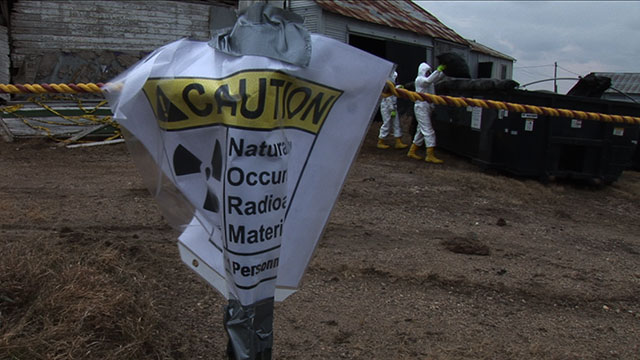
Larry Novak’s family has lived in western North Dakota since his great grandfather Anton Novak homesteaded in the region over one hundred years ago. Generations have farmed and ranched near the banks of the Missouri River. And since the early 1950s, the Novaks have dealt with the impacts from oil drilling, community disruptions and environmental damages that have come with the region’s many booms and busts.
“This time, it’s different,” Novak, a cattle rancher and chairman of Tri-Township in McKenzie County, North Dakota, told Truthout.
Over the last 10 years North Dakota has been home to an unprecedented surge of industrial oil extraction activity. New technologies, such as fracking and horizontal drilling, have allowed companies to access previously inaccessible deep oil shale reserves. Between 2006 and 2012 North Dakota rose from eighth to second in oil production nationally. In 2006, the state produced 39 million barrels of oil. By 2014 that number had grown to over 390 million barrels of oil per year.
“All that oil,” Novak told Truthout, “produces a lot of waste. And it has to go somewhere.”
In January of 2016, Novak found out that the “special” waste landfill — which is what the state of North Dakota calls landfills that are permitted to accept oil field waste — just six miles north of his ranch applied to receive a permit from the state to accept oil field waste that had higher levels of radioactivity. That landfill, known as the IHD waste disposal plant, sits in the middle of a miles-wide oxbow of the meandering Missouri River. A pile of dirt, 10 stories high, overlooks the wide-open spaces of the prairie, and underneath is waste from the oil fields.
“The landfill operator and the health agency tell us that this is as safe as having banana peels in the landfill. That it is just as safe as having granite counter tops in your house,” Novak said. “That insulted my intelligence.”
Novak started having township meetings to bring community members together to talk about what they were facing.
“There are rural water lines that run under that facility, in plastic pipes, not lead. There are people that live within a mile of it. Dust blows off the waste pile toward their homes. This is not okay, and the health department won’t lift a finger for us,” Novak told Truthout.
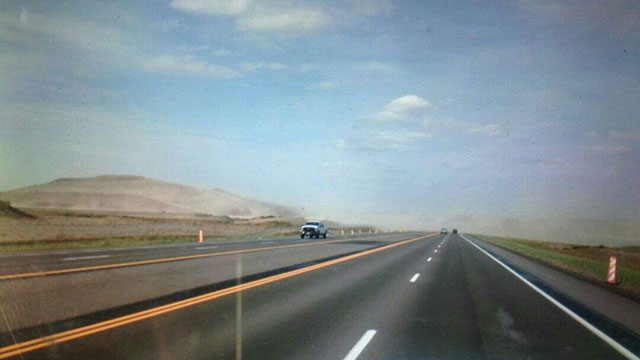 Dust blows off the IHD “special” waste facility near Alexander, North Dakota, that was recently found to have accepted over 950 tons of illegal radioactive oil field waste. (Photo: Brenna Kerr)
Dust blows off the IHD “special” waste facility near Alexander, North Dakota, that was recently found to have accepted over 950 tons of illegal radioactive oil field waste. (Photo: Brenna Kerr)
One of those people who live less than a mile from the IHD facility is Susan Perry. One day, the local bus driver who picks up dozens of kids who live in Perry’s neighborhood stopped by her house to ask if Perry would sign a petition to the North Dakota Department of Health. The petition asked the state not to increase the allowable radiation limits for oil field waste dumped in landfills. Perry was alarmed. She knew the landfill accepted oil field waste but had never heard anyone talk about radioactivity.
“No one,” she told Truthout, “would choose to buy a house next to a radioactive waste dump. There are families here. There are little kids.”
How did it come to pass that Novak and Perry were in danger of living next to a radioactive landfill? In 2014, oil prices plummeted and along with them, oil company profits. Energy companies began pressuring the state of North Dakota to revise the radioactive waste disposal laws. Disposing of radioactive waste in-state, instead of shipping it out of state to places that were permitted to handle higher levels of radiation, would be much cheaper. State officials figured they could save the oil industry almost $120 million dollars a year statewide by increasing the amount of radiation allowed in landfills.
“You’re talking hundreds of dollars to transport, versus tens of thousands of dollars if regulations are changed,” Kari Cutting, vice president of the North Dakota Petroleum Council told the Dickinson Press.
The oil companies got what they wanted. The North Dakota state legislature approved a bill allowing Department of Health to create a new radioactive waste limit. Then, on August 11, 2015, the North Dakota Health Council, an 11-member governing body of the Department of Health, held a meeting to increase the picocurie limit from five to 50 picocuries per gram. Picocuries are how radiation is measured. The council did not properly notify the public, and two citizen’s groups, the Dakota Resource Council and the North Dakota Energy Industry Waste Coalition sued the North Dakota Health Council claiming the meeting was held illegally.
Because of massive public outrage over the decision and an opinion from the North Dakota attorney general that found the meeting was held illegally, the health council decided to hold another meeting to re-approve the radiation limits. Novak, Perry and about 50 of their fellow community members travelled over 200 miles to the state’s capital, Bismarck, to try to convince the state health council not to approve the increased radiation levels. They argued the regulations were not based on science or credible data and more time was needed for a decision that would have such a lasting impact on people and the environment.
Members of the public were only given 20 minutes total to make their case.
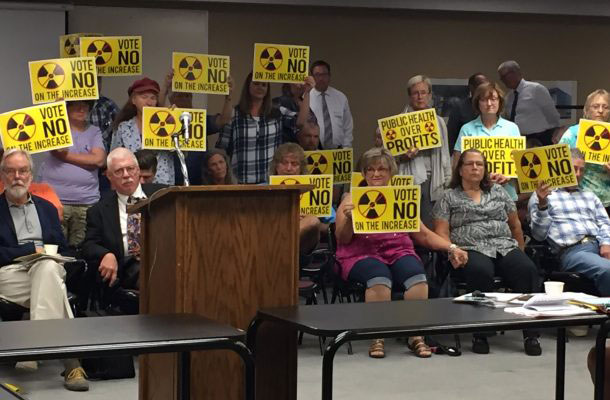 People who live near the IHD landfill in western North Dakota gather in Bismarck to ask the North Dakota Health Council not to increase radiation limits for oil field waste in landfills. (Photo: Dakota Resource Council)
People who live near the IHD landfill in western North Dakota gather in Bismarck to ask the North Dakota Health Council not to increase radiation limits for oil field waste in landfills. (Photo: Dakota Resource Council)
“They had already made their minds up, I could tell. Most of them wouldn’t even look us in the eye — they knew what they were doing was wrong,” Perry said. “They’re the state health department. You’d think they’d be concerned about people’s health, not oil company profits.”
The council voted 10-0 to implement the increased radiation limits.
What the people at the hearing didn’t know at the time was that the landfill near their homes, the IHD waste facility, whose owners were trying to get a permit to accept radioactive oil field waste, already had over 950 tons of illegally dumped radioactive waste buried in the facility that had readings over the 5-picocurie limit — and even over the proposed 50-picocurie limit. The health department and the health council that were holding the public hearing, however, did know and didn’t say a word to the people who attended the meeting.
Darrell Dorgan, a journalist, filmmaker and founder of the North Dakota Energy Industry Waste Coalition has been tracking this issue in North Dakota for years. He told Truthout that the state has no idea where hundreds of thousands of tons of radioactive oil waste are.
“Oil companies in North Dakota have bought the best state government you can buy,” Dorgan said.
Radioactive Waste in the Bakken Oil Field
According to a report on oil and gas radioactive waste by the Western Organization of Resource Councils, in 2001 North Dakota’s waste facilities took in around 10,000 tons of oil field solid waste; in 2013 they took in nearly 1.8 million tons, a 180-fold increase. These numbers do not account for the amounts of radioactive waste generated, which until last year, were not tracked by the state. The numbers also do not include the waste being shipped out of state and disposed of elsewhere. Nationally, there is no entity that tracks how many tons of waste the fossil fuel boom generates or where it ends up.
Because of hydraulic fracturing, the oil waste produced in the Bakken isn’t inert. Fracking has changed the profile of oil and gas waste, both in terms of radioactivity and the volume of waste produced. The geologic formations that contain oil and gas deposits also contain naturally occurring radionuclides, which are referred to as Naturally Occurring Radioactive Materials (NORM). These include uranium, thorium, radium, potassium, lead-210 and polonium-210. Fracking concentrates the naturally occurring radionuclides and exposes them to the surface environment and human contact. As a result, these wastes are classified as Technologically Enhanced Naturally Occurring Radioactive Material (TENORM).
TENORM waste is not regulated by the federal government even though it is known to affect human health. It is found in equipment and pipes used in oil drilling and in “filter socks,” which are large bags used to filter solids from fluids during the fracking process. What flows through the socks are elements found in the shale and the chemical additives in the fracking fluid. That wastewater, and the socks it flows through, end up concentrating radioactive material. Each filter sock has a range of five to 80 picocuries per filter. Each curie represents around one gram of radium, the primary radioactive component found in wastewater during the drilling process.
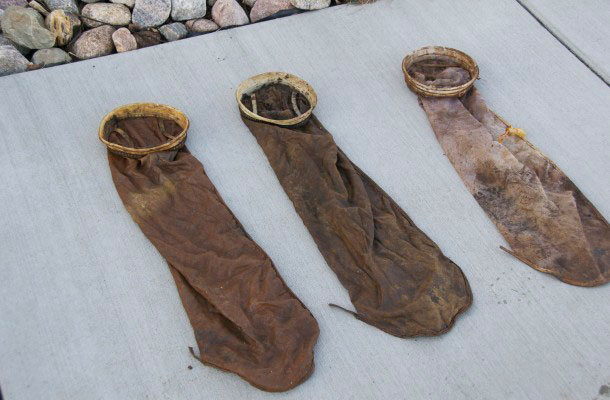 Radioactive filter socks sit on a table in an abandoned gas station in Noonan, North Dakota. (Photo: North Dakota Department of Health)
Radioactive filter socks sit on a table in an abandoned gas station in Noonan, North Dakota. (Photo: North Dakota Department of Health)
In a 2014 article in Environmental Health Perspectives examining TENORM waste in fracking fluid, the authors found that radioactive particles are most dangerous when inhaled or ingested. The authors note that:
When inhaled, radon can cause lung cancer, and there is some evidence it may cause other cancers such as leukemia. Consuming radium in drinking water can cause lymphoma, bone cancer, and leukemias. Radium also emits gamma rays, which raise cancer risk throughout the body from external exposures.
Most scientists agree that there is no such thing as a “safe” dose of radiation, no matter how small. And the small doses are the ones that are understood the least.
Dorgan believes, one day soon, parts of western North Dakota will be declared a federal superfund site.
“Here’s the deal,” Dorgon told Truthout, “Where has all the TENORM waste been disposed of for the last 10 years? The state of North Dakota certainly doesn’t know. And, the new TENORM regulations aren’t tough enough to protect the people from it. And even if they were strong, the state won’t enforce them!”
Where Has All the Radioactive Waste Gone?
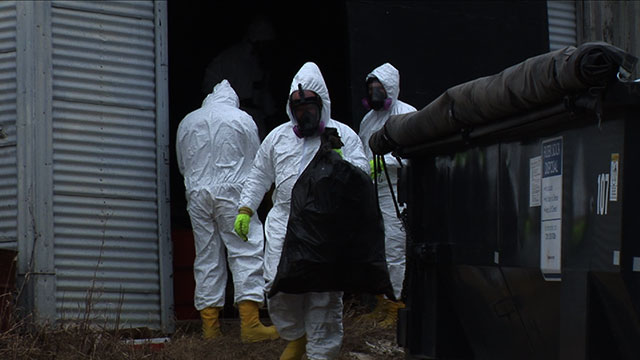 Cleanup workers from the North Dakota Department of Health remove radioactive filter socks from an abandoned gas station in Noonan, North Dakota. (Photo: David Geck)
Cleanup workers from the North Dakota Department of Health remove radioactive filter socks from an abandoned gas station in Noonan, North Dakota. (Photo: David Geck)The short answer is, no one knows. Illegal radioactive waste-dumping in North Dakota is widespread. Because oil companies were not legally allowed to dispose of radioactive oil field waste that was higher than 5 picocuries in landfills, companies trucked the waste to licensed facilities in Idaho, Colorado and Montana. Shipping costs ate into profits and some companies began dumping radioactive waste in abandoned buildings, on the side of dirt roads or in the middle of fields. Others concealed contaminated materials in non-radioactive loads in order to sneak them into landfills.
“There have been farmers that have found socks on the prairie. People have been dumping on them on the Fort Berthold Indian Reservation,” Novak told Truthout. “There are socks throughout the country that we might never find. The state apparently thinks everything is fine and everything is going to be self-regulating and the companies are credible. Well, they’re not credible — they don’t care about us, they take their profits and leave the state.”
Illegal waste dumping in North Dakota over the last couple of years has made headlines locally and nationally.
In 2013, during an inspection on the Fort Berthold Indian Reservation in North Dakota, the Environmental Protection Agency (EPA) found a deserted truck bed loaded with oil filter socks. The Fort Berthold Tribe has found oil filter socks in dumpsters for community use and along roads throughout the reservation.
Also in 2013, Rick Schreiber, director of the McKenzie County Solid Waste Department, discovered 985 illegal filter socks in the McKenzie County municipal landfill.
In February 2014 trailers loaded with thousands of pounds of oil filter socks and other debris were found parked on a rural property southwest of Watford City, North Dakota. In another incident that year, authorities found six separate rooms containing over 200 industrial-sized black garbage bags full of filter socks in an abandoned gas station in the small town of Noonan, North Dakota (population 120).
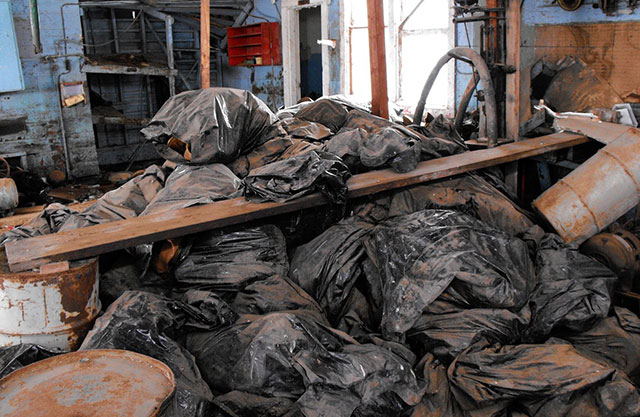 Radioactive filter socks sit in an abandoned gas station in Noonan, North Dakota. (Photo: North Dakota Department of Health)
Radioactive filter socks sit in an abandoned gas station in Noonan, North Dakota. (Photo: North Dakota Department of Health)In April 2014 authorities found 15 garbage cans and 25 bags full of oil filter socks north of Crosby, North Dakota, about five miles from the Canadian border.
Records obtained by the Associated Press show that in 2014 alone, people were caught nearly 150 times trying to illegally dump loads of oil field waste at two of the biggest landfills in western North Dakota. None of the incidents resulted in fines or any sanctions from the state. At most, the regulators required that the offenders promise to properly dispose of the waste.
In 2015 100 radioactive filter socks were found dumped behind a business at the north end of Williston, North Dakota.
The state’s regulators have been heavily criticized for either levying no fines for illegal dumping of waste or reducing fines dramatically.
For example, Zenith Produced Water, LLC, a company that illegally dumped radioactive waste in the abandoned gas station in Noonan was originally fined $800,000, but that penalty was dropped to just $20,000 in cleanup costs. The rest of the fine was suspended pending good behavior — i.e., not illegally dumping radioactive material — for one year.
Plus, radioactivity isn’t just in oil field waste. It’s also in the dirt and the water where fracking spills have occurred. A recent study by researchers at Duke University found that wastewater spills from fracking in North Dakota have caused widespread water and soil contamination. Since 2007, there have been approximately 3,900 brine spills reported to the North Dakota Department of Health by well operators.
Researchers found high levels of ammonium, selenium, lead and other toxic contaminants as well as high salts in the brine-laden wastewater, which primarily comes from hydraulically fractured oil wells. Streams polluted by the wastewater contained levels of contaminants that often exceeded federal guidelines for safe drinking water or aquatic health. Soil at the spill sites was contaminated with radium, a naturally occurring radioactive element found in brines, which chemically attached to the soil after the spill water was released.
At one site, the researchers were still able to detect high levels of contaminants in spill water four years after the spill occurred.
“Unlike spilled oil, which starts to break down in soil, these spilled brines consist of inorganic chemicals, metals and salts that are resistant to biodegradation,” said Nancy Lauer, a Ph.D. student at Duke University’s Nicholas School of the Environment. “They don’t go away; they stay. This has created a legacy of radioactivity at spill sites.”
And Novak points out that the groundwater below and adjacent to North Dakota special waste sites is already being contaminated by oilfield wastes, and likely also by TENORM wastes. This is substantiated by the findings in a July 2016 study at the IHD Solids Management facility conducted for the McKenzie County Board of Commissioners.
Will Western North Dakota Become a Superfund Site?
The North Dakota Health Department tries to paint a rosy picture of its handling of the radioactive waste problem in the state.
In 2014 David Glatt, head of the North Dakota Health Department’s environmental health division, told the Billings Gazette that worries over North Dakota becoming a superfund site are overblown.
“The assessment of it being uncontrolled, those are not the facts we have at hand. A fair amount of it is being handled appropriately. The larger companies are doing it right because they don’t want the liability and they don’t want to go in and clean it up,” Glatt told the Gazette.
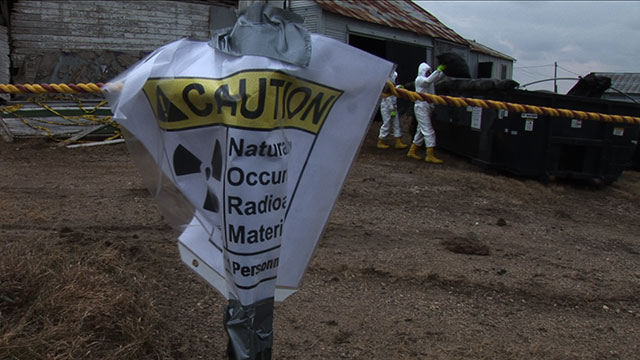 A caution sign is taped to a fence post outside an abandoned gas station in Noonan, North Dakota, where radioactive oil field socks were found. (Photo: David Geck)
A caution sign is taped to a fence post outside an abandoned gas station in Noonan, North Dakota, where radioactive oil field socks were found. (Photo: David Geck)
However, Robert Moran, Ph.D., a hydrologist and geochemist who has examined the new North Dakota TENORM regulations for the Dakota Resources Council takes issue with this assessment.
“The state of North Dakota doesn’t know what the facts are,” Moran told Truthout. “They don’t have any independent data to properly assess the severity of the radioactive waste problem.”
He believes strongly that these new regulations are just an exercise in paperwork, not an actual attempt to deal with the problem.
“Where in the hell is the data? Let’s see some credible numbers,” Moran said. “The public needs to know that the data comes from independent sources, not a contractor that is paid for and directed by the oil companies. That data is useless. The problem with figuring out what to do here is political, not technical. We can’t evaluate the problem without competent, independent data, not garbage data.”
In Moran’s written testimony on the radioactive waste regulations he found extensive problems:
All sources I have contacted during my review indicate that the State is not enforcing the current TENORM standard…. Almost all NDDH [North Dakota Department of Health] responses imply that a regulation will magically control the disposal of TENORM — as opposed to implementing some form of independent state oversight and monitoring. Such an approach simply adds more regulations and paperwork, but no REAL enforcement, now or in the future.
When Truthout asked Moran what he thought of the radioactive oil waste being compared to banana peels and granite counter tops by the health department, he laughed.
“They are completely disregarding the form of radioactivity,” he said. “What kind of radioactivity are we talking about and what pathways are we talking about? How is it transmitted to humans? It is a simple-minded way of diverting the public.”
On September 16, 2016, the North Dakota Energy Industry Waste Coalition and Dakota Resource Council called for a formal inquiry into the Health Department’s knowledge and omission of known radioactive waste violations at a Health Council meeting in August where they advocated increasing the allowable radioactive waste levels. The groups sent Governor Jack Dalrymple the request for investigation via letter on September 9, 2016.
The groups charge that the Health Department withheld the results of its own “sting operation” conducted in May and June in which the IHD facility was caught with 950 tons of illegal radioactive waste during the August 9 public hearing.
Two other companies, Secure Energy Services and Gibson Energy, were in the process of applying for expanded permits under the recently ratified new rules when the health department discovered illegal material on site at both locations during the same inspection and both applications are under review.
There has been no response from the state to the group’s letter. Novak isn’t surprised but he’s not backing down. He is committed to protecting his community and knows what he is up against.
“The oil companies don’t care what happens to us but we are standing up,” he said. “People are saying enough is enough. The fight goes on.”
Our most important fundraising appeal of the year
December is the most critical time of year for Truthout, because our nonprofit news is funded almost entirely by individual donations from readers like you. So before you navigate away, we ask that you take just a second to support Truthout with a tax-deductible donation.
This year is a little different. We are up against a far-reaching, wide-scale attack on press freedom coming from the Trump administration. 2025 was a year of frightening censorship, news industry corporate consolidation, and worsening financial conditions for progressive nonprofits across the board.
We can only resist Trump’s agenda by cultivating a strong base of support. The right-wing mediasphere is funded comfortably by billionaire owners and venture capitalist philanthropists. At Truthout, we have you.
We’ve set an ambitious target for our year-end campaign — a goal of $250,000 to keep up our fight against authoritarianism in 2026. Please take a meaningful action in this fight: make a one-time or monthly donation to Truthout before December 31. If you have the means, please dig deep.